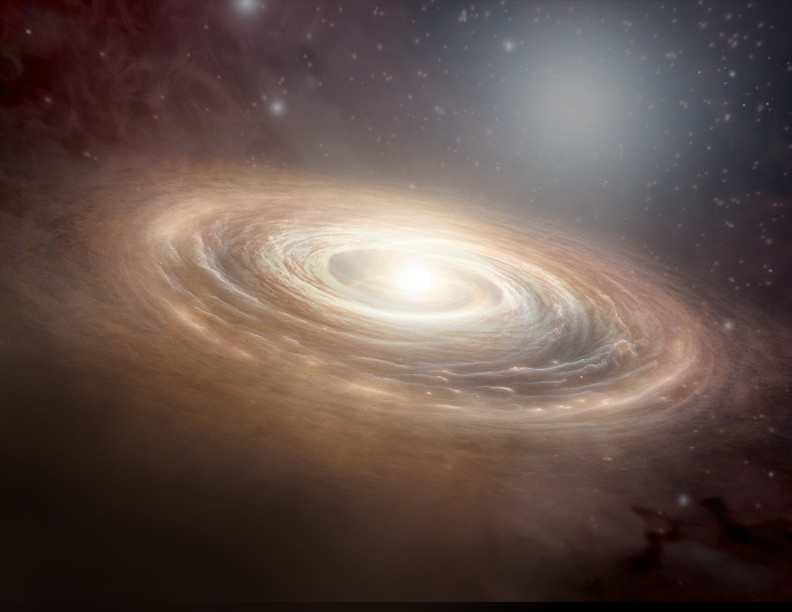
This artist's concept depicts a protoplanetary disk - dust and gas caught in the gravity of a young star. A new study found that the lifetime of the gas within the disk determines the timescale for the formation of planets. Illustration: NSF/AUI/NSF NRAO/S.Dagnello
An international team of scientists led by astronomers from the University of Wisconsin-Madison has produced the most accurate measurement of the gases swirling around young stars and how their mass changes over time. The discovery joins many pieces of a puzzle that may reveal which kinds of planets form - rocky Earth-types, gas giants like Jupiter, or balls of ice in the Neptune mold - as star systems mature.
The researchers used an array of 66 massive radio telescopes, the Atacama Large Millimeter/submillimeter Array, perched at 16,000 feet in the Chilean Andes Mountains, to study the disks of gas spinning in the gravity of each of 30 young stars.
"In order to know what type of planets and how many planets you can have in a system, the fundamental requirement is understanding the mass in the disk around the young star. We call those disks protoplanetary disks," says Ke "Coco" Zhang, professor of astronomy at UW-Madison and leader of the ALMA Survey of Gas Evolution of Protoplanetary Disks.
The stars the researchers focused on ranged from less than 1 million years old to over 5 million years old. That may sound ancient, but those are still diaper days for a star.
"Our solar system is about 4.5 billion years old," Zhang says. "So, these systems that are just a few million years old are really just babies."
Baby stars likely start out hanging on to protoplanetary disks that are, by mass, about 1% dust and 99% gas - mostly hydrogen and helium.
Leon Trapman, a UW-Madison postdoctoral researcher in Zhang's lab at the time of the study, guided the analysis of the electromagnetic radiation emitted by the disks, comparing the signatures of various gas molecules to get an unprecedented measurement of their masses. Previous studies had relied on a fixed ratio of carbon monoxide - a molecule that is not particularly abundant in the disks, but easy to "see" with a radio telescope - to the much more abundant hydrogen. The new study employed a finer method. By tracking the intensity of the signature for molecules of an ion, N2H+, which grows more numerous as carbon monoxide thins out, Trapman and collaborators could account for the way the disks' gas content changes over their first few million years.
"Now, we can see that gas mass is decreasing very quickly in the first million years of protoplanetary disks and then gas mass decreases slowly, while dust mass probably decreases steadily over time," says Zhang. "So, if you want to form any gas giants like Jupiter, you have to get to work on that while more of the gas is still around, and that's only a few million years."
The formation process for rocky planets, like ours, can play out at a more leisurely pace over hundreds of millions of years, thanks to the persistence of the dust from which they're made.
The new findings, which will soon be published in a special issue of the Astrophysical Journal alongside a series of other results from the project, also suggest that the gases lost from the young stars' disks may be "blown" away by a sort of disk wind. When the gas molecules cross magnetic field lines in space, they can be accelerated out of their orbit and cut loose from the disks.
Now Zhang and collaborators will turn to measuring the chemical composition of the innermost region in protoplanetary disks, where rocky planets like Earth would form. The James Webb Space Telescope (JWST) is better than the Atacama array at tracking hot materials in the inner disk region, and the researchers recently acquired JWST data on their 30 target disks.
"With that data, we can look at the materials close-in in the disk, which is where we think rocky planets are forming," Zhang says. "If we can look at the chemical composition of materials like water and organics, we can understand how those change over the evolution of the disks."
Learn more about the findings from the ALMA Survey of Gas Evolution of Protoplanetary Disks from on the National Radio Astronomy Observatory's website.
The research was supported by grants from the National Science Foundation (2205617 and 2205870).






